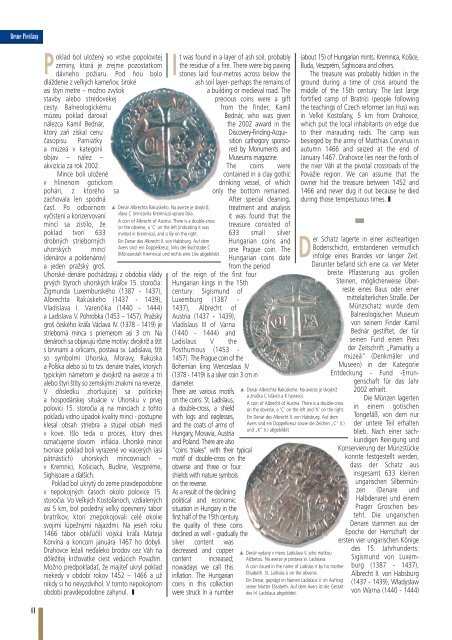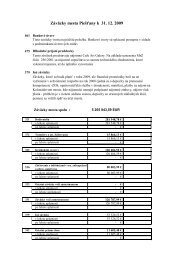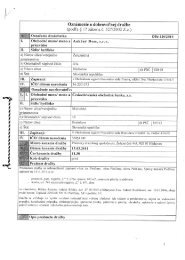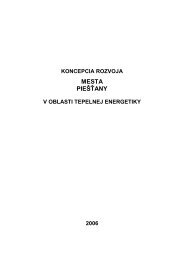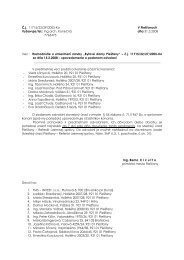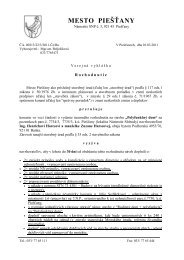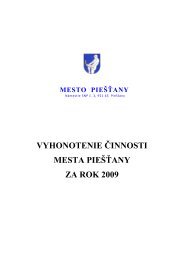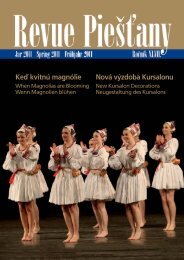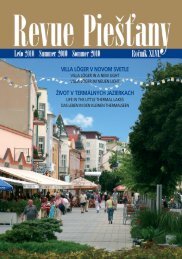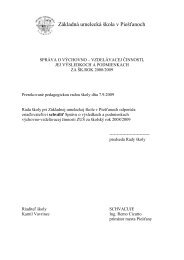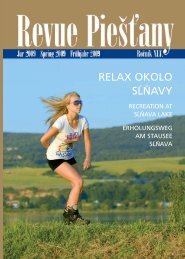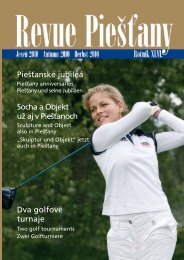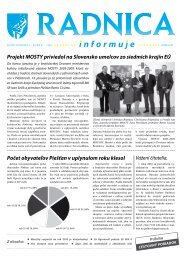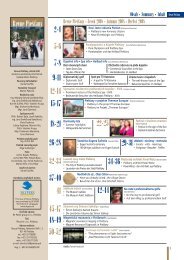LETO 2009 - Piešťany
LETO 2009 - Piešťany
LETO 2009 - Piešťany
Erfolgreiche ePaper selbst erstellen
Machen Sie aus Ihren PDF Publikationen ein blätterbares Flipbook mit unserer einzigartigen Google optimierten e-Paper Software.
44<br />
Poklad bol uložený vo vrstve popolovitej<br />
zeminy, ktorá je zrejme pozostatkom<br />
dávneho požiaru. Pod ňou bolo<br />
dláždenie z veľkých kameňov, široké<br />
asi štyri metre – možno zvyšok<br />
stavby alebo stredovekej<br />
cesty. Balneologickému<br />
múzeu poklad daroval<br />
nálezca Kamil Bednár,<br />
ktorý zaň získal cenu<br />
časopisu Pamiatky<br />
a múzeá v kategórii<br />
objav – nález –<br />
akvizícia za rok 2002.<br />
Mince boli uložené<br />
v hlinenom gotickom<br />
pohári, z ktorého sa<br />
zachovala len spodná<br />
časť. Po odbornom<br />
vyčistení a konzervovaní<br />
mincí sa zistilo, že<br />
poklad tvorí 633<br />
drobných strieborných<br />
uhorských mincí<br />
(denárov a poldenárov)<br />
a jeden pražský groš.<br />
Uhorské denáre pochádzajú z obdobia vlády<br />
prvých štyroch uhorských kráľov 15. storočia:<br />
Žigmunda Luxemburského (1387 - 1437),<br />
Albrechta Rakúskeho (1437 - 1439),<br />
Vladislava I. Varenčika (1440 - 1444)<br />
a Ladislava V. Pohrobka (1453 – 1457). Pražský<br />
groš českého kráľa Václava IV. (1378 - 1419) je<br />
strieborná minca s priemerom asi 3 cm. Na<br />
denároch sa objavujú rôzne motívy: dvojkríž a štít<br />
s brvnami a orlicami, postava sv. Ladislava, štít<br />
so symbolmi Uhorska, Moravy, Rakúska<br />
a Poľska alebo sú to tzv. denáre triales, ktorých<br />
typickým námetom je dvojkríž na averze a tri<br />
alebo štyri štíty so zemskými znakmi na reverze.<br />
V dôsledku zhoršujúcej sa politickej<br />
a hospodárskej situácie v Uhorsku v prvej<br />
polovici 15. storočia aj na minciach z tohto<br />
pokladu vidno úpadok kvality mincí - postupne<br />
klesal obsah striebra a stúpal obsah medi<br />
v kove. Išlo teda o proces, ktorý dnes<br />
označujeme slovom inflácia. Uhorské mince<br />
tvoriace poklad boli vyrazené vo viacerých (asi<br />
pätnástich) uhorských mincovniach –<br />
v Kremnici, Košiciach, Budíne, Veszpréme,<br />
Sighisoare a ďalších.<br />
Poklad bol ukrytý do zeme pravdepodobne<br />
v nepokojných časoch okolo polovice 15.<br />
storočia. Vo Veľkých Kostoľanoch, vzdialených<br />
asi 5 km, bol posledný veľký opevnený tábor<br />
bratríkov, ktorí znepokojovali celé okolie<br />
svojimi lúpežnými nájazdmi. Na jeseň roku<br />
1466 tábor obkľúčili vojská kráľa Mateja<br />
Korvína a koncom januára 1467 ho dobyli.<br />
Drahovce ležali neďaleko brodov cez Váh na<br />
dôležitej križovatke ciest vedúcich Považím.<br />
Možno predpokladať, že majiteľ ukryl poklad<br />
niekedy v období rokov 1452 – 1466 a už<br />
nikdy si ho nevyzdvihol. V tomto nepokojnom<br />
období pravdepodobne zahynul. z<br />
s Denár Albrechta Rakúskeho. Na averze je dvojkríž,<br />
vľavo C (mincovňa Kremnica) vpravo ľalia.<br />
A coin of Albrecht of Austria. There is a double-cross<br />
on the obverse, a 'C' on the left (indicating it was<br />
minted in Kremnica), and a lily on the right.<br />
Ein Denar des Albrecht II. von Habsburg. Auf dem<br />
Avers sind ein Doppelkreuz, links der Buchstabe C<br />
(Münzanstalt Kremnica) und rechts eine Lilie abgebildet.<br />
I<br />
t was found in a layer of ash soil, probably<br />
the residue of a fire. There were big paving<br />
stones laid four-metres across below the<br />
ash soil layer- perhaps the remains of<br />
a building or medieval road. The<br />
precious coins were a gift<br />
from the finder, Kamil<br />
Bednár, who was given<br />
the 2002 award in the<br />
Discovery-Finding-Acquisition<br />
cathegory sponsored<br />
by Monuments and<br />
Museums magazine.<br />
The coins were<br />
contained in a clay gothic<br />
drinking vessel, of which<br />
only the bottom remained.<br />
After special cleaning,<br />
treatment and analysis<br />
it was found that the<br />
treasure consisted of<br />
633 small silver<br />
Hungarian coins and<br />
one Prague coin. The<br />
Hungarian coins date<br />
from the period<br />
of the reign of the first four<br />
Hungarian kings in the 15th<br />
century: Sigismund of<br />
Luxemburg (1387 -<br />
1437), Albrecht of<br />
Austria (1437 - 1439),<br />
Vladislaus III of Varna<br />
(1440 - 1444) and<br />
Ladislaus V the<br />
Posthumous (1453 -<br />
1457). The Prague coin of the<br />
Bohemian king Wenceslaus IV<br />
(1378 - 1419) is a silver coin 3 cm in<br />
diameter.<br />
There are various motifs<br />
on the coins: St. Ladislaus,<br />
a double-cross, a shield<br />
with logs and eaglesses,<br />
and the coats of arms of<br />
Hungary, Moravia, Austria<br />
and Poland. There are also<br />
“coins triales” with their typical<br />
motif of double-cross on the<br />
obverse and three or four<br />
shields with nature symbols<br />
on the reverse.<br />
As a result of the declining<br />
political and economic<br />
situation in Hungary in the<br />
first half of the 15th century,<br />
the quality of these coins<br />
declined as well - gradually the<br />
silver content was<br />
decreased and copper<br />
content increased;<br />
nowadays we call this<br />
inflation. The Hungarian<br />
coins in this collection<br />
were struck in a number<br />
s Denár Albrechta Rakúskeho. Na averze je dvojkríž<br />
a značka C (vľavo) a K (vpravo).<br />
A coin of Albrecht of Austria. There is a double-cross<br />
on the obverse, a 'C' on the left and 'K' on the right.<br />
Ein Denar des Albrecht II. von Habsburg. Auf dem<br />
Avers sind ein Doppelkreuz sowie die Zeichen „C“ (l.)<br />
und „K“ (r.) abgebildet.<br />
(about 15) of Hungarian mints: Kremnica, Košice,<br />
Buda, Veszprém, Sighisoara and others.<br />
The treasure was probably hidden in the<br />
ground during a time of crisis around the<br />
middle of the 15th century. The last large<br />
fortified camp of Bratríci (people following<br />
the teachings of Czech reformer Jan Hus) was<br />
in Veľké Kostoľany, 5 km from Drahovce,<br />
which put the local inhabitants on edge due<br />
to their marauding raids. The camp was<br />
besieged by the army of Matthias Corvinus in<br />
autumn 1466 and seized at the end of<br />
January 1467. Drahovce lies near the fords of<br />
the river Váh at the pivotal crossroads of the<br />
Považie region. We can assume that the<br />
owner hid the treasure between 1452 and<br />
1466 and never dug it out because he died<br />
during those tempestuous times. z<br />
D<br />
s Denár vydaný v mene Ladislava V. jeho matkou<br />
Alžbetou. Na averze je postava sv. Ladislava.<br />
A coin issued in the name of Ladislas V by his mother<br />
Elisabeth. St. Ladislas is on the obverse.<br />
Ein Denar, geprägt im Namen Ladislaus V. im Auftrag<br />
seiner Mutter Elisabeth. Auf dem Avers ist die Gestalt<br />
des hl. Ladislaus abgebildet.<br />
er Schatz lagerte in einer ascheartigen<br />
Bodenschicht, entstandenen vermutlich<br />
infolge eines Brandes vor langer Zeit.<br />
Darunter befand sich eine ca. vier Meter<br />
breite Pflasterung aus großen<br />
Steinen, möglicherweise Überreste<br />
eines Baus oder einer<br />
mittelalterlichen Straße. Der<br />
Münzschatz wurde dem<br />
Balneologischen Museum<br />
von seinem Finder Kamil<br />
Bednár gestiftet, der für<br />
seinen Fund einen Preis<br />
der Zeitschrift „Pamiatky a<br />
múzeá“ (Denkmäler und<br />
Museen) in der Kategorie<br />
Entdeckung - Fund -Errun-<br />
genschaft für das Jahr<br />
2002 erhielt.<br />
Die Münzen lagerten<br />
in einem gotischen<br />
Tongefäß, von dem nur<br />
der untere Teil erhalten<br />
blieb. Nach einer sachkundigen<br />
Reinigung und<br />
Konservierung der Münzstücke<br />
konnte festgestellt werden,<br />
dass der Schatz aus<br />
insgesamt 633 kleinen<br />
ungarischen Silbermünzen<br />
(Denare und<br />
Halbdenare) und einem<br />
Prager Groschen besteht.<br />
Die ungarischen<br />
Denare stammen aus der<br />
Epoche der Herrschaft der<br />
ersten vier ungarischen Könige<br />
des 15. Jahrhunderts:<br />
Sigismund von Luxem-<br />
burg (1387 - 1437),<br />
Albrecht II. von Habsburg<br />
(1437 - 1439), Władysław<br />
von Warna (1440 - 1444)


